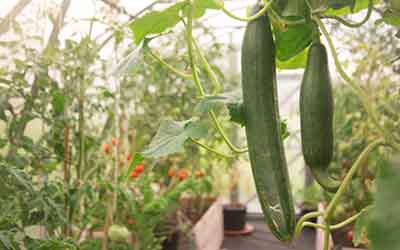Are you among those wishing to know the answer to does companion planting tomatoes and cucumbers work? Well, you are at the right place.
One of the most fascinating demonstrations of this balance can be found right in our gardens through a technique known as companion planting.
For centuries, farmers and gardeners have observed that certain plant combinations thrive when grown near each other. These symbiotic relationships between plants can offer a variety of benefits, ranging from enhanced growth to natural pest control.
Within the realm of companion planting, tomatoes and cucumbers stand out as a popular pair. Both of these plants are favorites in home gardens and on commercial farms alike, primarily for their culinary uses.
But beyond their delectable flavors, these two plants offer a harmonious relationship when grown together. This partnership brings out the best in both, ensuring healthier plants and potentially higher yields.
An Overview of companion planting tomatoes and cucumbers
In this blog post, we will look into the world of companion planting, specifically spotlighting the dynamics between tomatoes and cucumbers.
From understanding the science behind their partnership to practical tips for gardeners, get ready to uncover the wonders of this age-old gardening practice. Whether you’re a seasoned gardener or a beginner looking to maximize your garden’s potential, the synergy between tomatoes and cucumbers offers an exciting journey of discovery.
At its core, companion planting is a horticultural practice where different species of plants are grown together in close proximity to mutually benefit from each other.
Instead of looking at each plant as an isolated entity, companion planting takes a holistic approach, recognizing that certain plant pairings can enhance growth, flavor, and health of one or both partners. This method encourages biodiversity, creating a more resilient and symbiotic garden ecosystem.
The roots of companion planting run deep, tracing back thousands of years across various cultures. Indigenous peoples across the world, from the Native Americans to African and Asian tribes, intuitively understood the relationships between certain plants.
Benefits of Companion Planting
The advantages of companion planting are extensive, providing both ecological and practical benefits for gardens of all sizes:
Natural Pest Control
Certain plants can deter pests that would typically plague their neighbors. For example, marigolds are often planted next to various crops to repel nematodes and other soil-borne pests.
This can reduce or even eliminate the need for chemical pesticides, leading to a healthier garden ecosystem.
Soil Enrichment
Some plants, especially legumes like peas and beans, have the ability to fix nitrogen from the air and store it in their roots. When grown alongside nitrogen-loving plants, they can naturally boost the nutrient content of the soil.
Maximizing Space
Through strategic planning, gardeners can utilize space more efficiently by understanding the growth patterns of their plants. For instance, tall plants can provide shade for those that are heat-sensitive, while sprawling plants can be used as ground cover to suppress weeds.
Improved Plant Health and Yields
Healthy companion relationships can lead to stronger plants that are more resistant to diseases. This can translate to higher yields and better-quality produce.
Enhanced Flavor
Some gardeners swear by the improved flavors of crops grown in companion setups. For instance, planting basil near tomatoes is believed to enhance the flavor of the tomatoes.
Attracting Beneficial Insects
Certain plant combinations can lure in pollinators, ensuring better fruiting, or predatory insects that keep pest populations in check.

Overview of Tomato Plants
Tomatoes, known scientifically as Solanum lycopersicum, come in a vast array of varieties. They can be broadly categorized into two growth habits: determinate and indeterminate.
-
- Determinate Tomatoes: These are often called “bush” tomatoes. They grow to a specific height, usually around 3-4 feet, and then stop. All their fruit matures over a short period (usually a couple of weeks) and then the plant dies back.
- Indeterminate Tomatoes: These are “vining” tomatoes. They continue to grow, flower, and produce fruit until they’re killed by frost or another external factor. They can grow quite tall, often requiring staking or caging.
Growing Conditions
Tomatoes thrive in well-draining soil with a slightly acidic pH (6.2 to 6.8). They require full sun, with at least six to eight hours of sunlight daily.
Consistent watering is essential, especially as the fruits start to form. Irregular watering can lead to issues like blossom end rot.
Common Pests
Tomatoes aren’t without their adversaries. Some of the common pests include:
-
- Tomato Hornworms: Large green caterpillars that can strip a plant of its leaves almost overnight.
- Aphids: Tiny insects that suck the sap out of tomato plants, potentially transmitting diseases.
- Whiteflies: These can lead to the yellowing of leaves and reduced yields.
- Nematodes: Microscopic worms that attack the roots, often leading to wilting and stunted growth.
How Tomatoes Can Benefit from Companion Planting
Tomatoes, when paired with the right companions, can flourish even more vigorously. These benefits can include:
- Enhanced growth and flavor due to the nutrients and benefits provided by companion plants.
- Reduced pest populations as some companion plants act as repellents or attract beneficial predatory insects.
- Protection against diseases, as certain companions can improve soil health or reduce the spread of soil-borne pathogens.
Potential Companions and Adversaries of Tomato Plants
See below;
Companions
-
- Basil: Believed to enhance the flavor of tomatoes and repel pests like mosquitoes and whiteflies.
- Marigolds: These flowers are known to deter nematodes and other soil pests, protecting tomato roots.
- Carrots: When grown alongside tomatoes, carrots can help loosen the soil, allowing for better root growth for both.
- Nasturtiums: These flowers can act as a trap crop for aphids, drawing them away from tomato plants.
- Chives: Their pungent smell can deter many pests that might otherwise target tomatoes.
Adversaries
While many plants complement tomatoes, a few should be avoided in close proximity.
-
- Corn: Tomatoes and corn are attacked by the same pest, the tomato fruitworm, making it easier for this pest to damage both crops if they’re adjacent.
- Potatoes: Being in the same family, tomatoes and potatoes are susceptible to many of the same blights and diseases.
- Brassicas (like broccoli and cabbage): These can inhibit tomato growth when planted nearby.
Overview of Cucumber Plants
Cucumbers, scientifically named Cucumis sativus, are typically divided into three main categories based on their intended use:
-
- Slicing Cucumbers: These are the ones most commonly found in grocery stores, grown for fresh consumption. They have a thin skin, crisp texture, and are usually eaten raw in salads or sandwiches.
- Pickling Cucumbers: Smaller in size, these cucumbers are perfect for pickling due to their thick, bumpy skin and firm flesh. They hold up well during the pickling process.
- Burpless Cucumbers: These are often longer and have a thinner skin. They’re named for their reduced or absence of compounds that can cause burping in some people.
Growing Conditions
Cucumbers thrive in warm temperatures and are sensitive to frost. They prefer well-drained soil with a neutral to slightly alkaline pH level (around 6.0 to 7.5).
They demand full sun, requiring a minimum of six hours daily, and consistent watering. Overhead watering should be avoided as it can lead to mildew on the leaves. Instead, water at the base to keep the leaves dry.
Common Pests
Like tomatoes, cucumbers also face their share of adversaries in the garden:
-
- Cucumber Beetles: These pests not only munch on leaves, stems, and fruit but also transmit bacterial wilt.
- Aphids: They suck the sap from cucumber plants, leading to yellow, curled leaves and potential disease transmission.
- Powdery Mildew: A fungal disease that appears as white, powdery spots on leaves.
- Squash Bugs: While more common on squash, they can target cucumbers and suck the sap out of leaves.

Benefits of Companion Planting for Cucumbers
Cucumbers can enjoy a range of benefits when planted near suitable companions:
- Pest Deterrence: Some plants can naturally repel pests that are harmful to cucumbers.
- Shade and Support: Some taller plants can offer shade from intense sun and act as natural trellises for cucumber vines.
- Improved Soil Quality: Certain plants can enhance the soil’s nutrient content, benefiting cucumber growth.
Potential Companions and Adversaries of Cucumber Plants
See below;
Companions
-
- Beans: These legumes can fix nitrogen in the soil, providing this essential nutrient for cucumbers.
- Corn: Corn stalks can act as a natural trellis for cucumber vines, and their tall growth can offer partial shade.
- Sunflowers: Much like corn, sunflowers can provide support for cucumbers. Their deep roots also help in breaking the soil.
- Radishes: They can deter cucumber beetles and can be harvested before the cucumbers need more space to grow.
- Nasturtiums: These can repel a range of pests, including aphids and squash bugs.
Adversaries
While companion planting offers benefits, certain plants might not be favorable for cucumbers.
-
- Aromatic Herbs: Plants like sage and basil can inhibit the growth of cucumbers.
- Potatoes: They can compete for nutrients and water, and may also increase the risk of blight for cucumbers.
- Melons: Due to similarities in growth patterns and susceptibility to some of the same pests, it’s best to avoid planting cucumbers and melons too close together.
Why Tomatoes and Cucumbers Make Good Companions
Tomatoes and cucumbers, despite their distinct flavors and culinary applications, share many commonalities in the garden that make them well-suited companions. Here’s a closer look at why these two popular crops work well together:
Shared Needs and Benefits (Light, Soil Conditions, Water)
- Light: Both tomatoes and cucumbers have a strong preference for full sun, requiring at least six to eight hours of direct sunlight each day. This shared need ensures that when planted near each other, neither plant will out-compete the other for light.
- Soil Conditions: Both crops flourish in well-draining soil. While cucumbers prefer a slightly more alkaline environment and tomatoes thrive in slightly acidic conditions, their preferred pH ranges overlap, making it feasible to prepare a soil bed that caters to both.
- Water: Both tomatoes and cucumbers are thirsty plants, especially during fruit formation. Their shared requirement for consistent watering ensures that gardeners can use similar irrigation schedules for both, reducing the risk of over or under-watering one of the plants.
How Each Plant Can Deter Pests or Diseases for the Other
While neither tomato nor cucumber has a direct repellent effect on the primary pests of the other, their coexistence can still be mutually beneficial in terms of pest and disease management:
- Diversity: Simply having a diverse planting can sometimes deter pests. Pests tend to target mono-cropped areas more aggressively. When faced with a mix of plants, some pests may become less concentrated or might move on to other areas.
- Beneficial Insects: Both tomatoes and cucumbers can attract beneficial insects when they flower. These beneficial insects, like ladybugs or lacewings, can prey on pests such as aphids, which are common enemies for both crops.
How the Vine-like Growth of Cucumbers Can Be Complementary to the Upright Growth of Tomatoes
- Vertical vs. Horizontal Growth: While both crops can spread out, tomatoes tend to grow more vertically, especially if they’re indeterminate varieties and are staked or caged. On the other hand, cucumbers, particularly the vining types, tend to sprawl more horizontally or climb when given support.
- Use of Space: The upright growth of tomatoes allows cucumbers to utilize the under-space efficiently. This can be particularly beneficial for gardeners with limited space, as it maximizes the yield potential per square foot.
- Natural Trellising: While not a common practice, in some gardens, cucumber vines might find support on tomato cages or stakes. This can help elevate cucumber fruits off the ground, reducing the risk of rot or pest damage.
How to Implement Companion Planting with Tomatoes and Cucumbers
Creating a companion planting setup with tomatoes and cucumbers can enhance your garden’s productivity and health. Here’s a guide on how to get started:
Spacing and Arrangement Suggestions
- Tomatoes: Depending on the variety, tomatoes can be planted 18 to 36 inches apart. Indeterminate (vining) tomatoes usually require more space compared to determinate (bushy) ones.
- Cucumbers: Plant cucumbers about 36 to 48 inches apart if they’re vining types, and about 12 inches apart for bush varieties.
- Arrangement: Given the sprawling nature of cucumber vines and the upright growth of tomatoes, a common method is to plant a row of tomatoes, followed by a row of cucumbers. The tomatoes can provide some afternoon shade for cucumbers in particularly hot climates.
Soil Preparation and Watering Recommendations
Both plants thrive in well-draining soil.
Soil Preparation
-
- Begin by tilling or loosening the soil to about 12 inches deep.
- Enrich the soil with well-decomposed compost or aged manure.
- For tomatoes, you may want to add some crushed eggshells or bone meal to provide extra calcium and prevent blossom end rot.
- Test the soil pH; aim for a slightly acidic to neutral range (6.0 to 7.5). Adjust if necessary using lime (to raise pH) or sulfur (to lower pH).
Watering
-
- Both tomatoes and cucumbers require consistent watering. It’s especially crucial during their flowering and fruit-setting stages.
- Aim for deep watering sessions rather than frequent shallow ones. This encourages deep root growth.
- Avoid overhead watering, especially in the evenings, as this can lead to fungal diseases. Instead, use a drip system or soaker hose to water at the base of the plants.
Common Myths and Misconceptions
Companion planting is an ancient practice, a blend of traditional wisdom and observed science. With such long-standing practices often come myths and misconceptions.
Let’s debunk some of the common ones related to companion planting tomatoes and cucumbers and then reiterate the genuine foundations behind the technique.
Myth: Companion Planting is a Guaranteed Pest Deterrent
Reality: While some plants do have properties that can repel specific pests, companion planting is not a guaranteed solution to all pest problems. It’s one tool in an integrated pest management approach and should be combined with other organic or conventional strategies for best results.
Myth: Tomatoes and Cucumbers Can’t be Planted Together Due to Different Water Needs
Reality: Both tomatoes and cucumbers enjoy consistent watering, especially during fruiting. While their water needs might differ slightly, with attentive gardening, both can thrive side by side. Over or under-watering any plant can lead to issues, regardless of companions.
Myth: Tomatoes Will Make Cucumbers Taste Bitter
Reality: The taste of cucumbers is influenced by several factors, including variety, soil health, watering consistency, and temperature. While some gardeners believe certain plants can influence flavor, there’s no concrete evidence to suggest tomatoes specifically make cucumbers bitter.
Myth: Companion Planting Always Increases Yield
Reality: The main benefits of companion planting revolve around pest deterrence, soil enhancement, and efficient space use. While these factors can potentially increase yield, other gardening variables (like weather, soil quality, and overall care) play significant roles in harvest outcomes.
Myth: All Plants Have Beneficial Companions
Reality: While many plants have beneficial companions, not every plant combination results in mutual benefits. Some might be neutral, while others could be detrimental.
Conclusion on the companion planting tomatoes and cucumbers
As we’ve looked into the symbiotic relationship between tomatoes and cucumbers, we’ve seen how such partnerships can offer tangible benefits ranging from natural pest control to optimizing garden space.
The practice underscores the holistic nature of gardening, reminding us that plants, much like humans, are influenced by their neighbors and surroundings.
The advantages of companion planting encompass not only pest deterrence and soil enrichment but also the promotion of biodiversity and resilience within our gardens. By observing the intricate relationships between plants, we tap into a sustainable method of gardening that harmonizes with nature rather than working against it.
Therefore, while the principles of companion planting provide a robust guideline, the true magic lies in personal observation and experimentation.
To all gardeners, both seasoned and budding, let the relationship between tomatoes and cucumbers serve as an inspiring example of nature’s potential partnerships.
Embrace the spirit of curiosity. Experiment with different plant combinations, observe the results, and continually adapt. Your garden is a canvas, ever-evolving, and ripe with possibilities.
Through hands-on learning and observation, not only will your garden flourish, but you’ll also cultivate a deeper connection with the earth and the intricate web of life it sustains.
Recommendations
How To Become An Agriculturist



